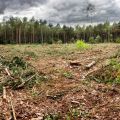‘Spectacular’ new find: Roman military camps identified in Arabian desert by Oxford archaeologists using satellite images
27 April 2023
Three new Roman fortified camps have been identified across northern Arabia by a remote sensing survey by the University of Oxford’s School of Archaeology. Their paper, published today in the journal Antiquity, reports the discovery may be evidence of a probable undocumented military campaign across south east Jordan into Saudi Arabia.
The camps were identified using satellite images. According to the research team, they may have been part of a previously undiscovered Roman military campaign linked to the Roman takeover of the Nabataean Kingdom in AD 106 CE, a civilisation centred on the world-famous city of Petra, located in Jordan.
Dr Michael Fradley, who led the research and first identified the camps on Google Earth, suggests there is little doubt about the date of the camps. He says, ‘We are almost certain they were built by the Roman army, given the typical playing card shape of the enclosures with opposing entrances along each side. The only notable difference between them is that the westernmost camp is significantly larger than the two camps to the east.’
According to Dr Mike Bishop, an expert on the Roman military, ‘These camps are a spectacular new find and an important new insight into Roman campaigning in Arabia. Roman forts and fortresses show how Rome held a province, but temporary camps reveal how they acquired it in the first place.’
The camps would have been built by the army as temporary defended stations when they were marching on campaign. Dr Fradley adds, ‘The level of preservation of the camps is really remarkable, particularly as they may have only been used for a matter of days or weeks…They went along a peripheral caravan route linking Bayir and Dûmat al-Jandal. This suggests a strategy to bypass the more used route down the Wadi Sirhan, adding an element of surprise to the attack. It is amazing that we can see this moment in time played out at a landscape scale.’
Professor Andrew Wilson, a co-author on the paper, says, ‘These marching camps - if we are correct in dating them to the early second century - suggest the Roman annexation of the Nabataean Kingdom following the death of the last king, Rabbel II Soter in AD 106, was not an entirely straightforward affair, and that Rome moved quickly to secure the kingdom.’
Given the distance between each camp is 37 km to 44 km, the team speculate it was too far to be crossed by infantry in a day and were instead built by a cavalry unit who could travel over such barren terrain in a single day, possibly on camels.
On the basis of the distance between the camps there is also a suggestion that another camp may have been located further west at the later Umayyad fort and well station at Bayir.
The newly discovered camps run in a straight line toward Dûmat al-Jandal in what is now Saudi Arabia, but which was then a settlement in the east of the Nabataean kingdom. It suggests Rome had to force its takeover, whereas the surviving Roman history argues the transfer of power was a peaceful event at the end of the reign of the last Nabataean king.
Archaeologists still need to confirm the date of the camps through investigation on the ground, but there are other questions that need to be answered. Professor Wilson questions, ‘Why does the western camp have twice the capacity of the other two? Did the force split, and if so, where did the other half go? Was it half wiped out in a battle, or did they remain in the western camp to resupply the other camps with water?’
Notes for editors
For more information and interviews, please contact Michael Fradley [email protected] (Mobile 07800 858974)
The camps were identified by the Endangered Archaeology in the Middle East and North Africa project (EAMENA), and were later photographed by the Aerial Archaeology in Jordan project (APAAME).
The research is supported by the Arcadia Fund.
About the School of Archaeology
Oxford’s School of Archaeology is a lively and diverse community of archaeologists. Our work takes in the full scope of human history, from early hunter-gatherers through to the origins of agriculture, the classical and medieval worlds and the ‘contemporary past’, as well as the environmental settings in which they existed. We work in just about every inhabited part of the world, and using the full range of theories, methods and techniques available to archaeologists. The past is of vital interest to the present, because it raises complex issues of identity, ethics and belonging that we see as crucial areas for debate.
About the University of Oxford
Oxford University has been placed number one in the Times Higher Education World University Rankings for the seventh year running, and number two in the QS World Rankings 2022. At the heart of this success are the twin-pillars of our ground-breaking research and innovation and our distinctive educational offer.
Oxford is world-famous for research and teaching excellence and home to some of the most talented people from across the globe. Our work helps the lives of millions, solving real-world problems through a huge network of partnerships and collaborations. The breadth and interdisciplinary nature of our research alongside our personalised approach to teaching sparks imaginative and inventive insights and solutions.
 New algorithm supercharges climate models and could lead to better predictions of future climate change
New algorithm supercharges climate models and could lead to better predictions of future climate change
 New study to improve vaccines and therapeutics development
New study to improve vaccines and therapeutics development
 Dr Ashwin Jainarayanan selected for 2024 Schmidt Science Fellow program
Dr Ashwin Jainarayanan selected for 2024 Schmidt Science Fellow program
 Nature degradation could cause a 12% loss to UK GDP
Nature degradation could cause a 12% loss to UK GDP
 Alok Sharma to join the Oxford Martin School as a Visiting Fellow
Alok Sharma to join the Oxford Martin School as a Visiting Fellow